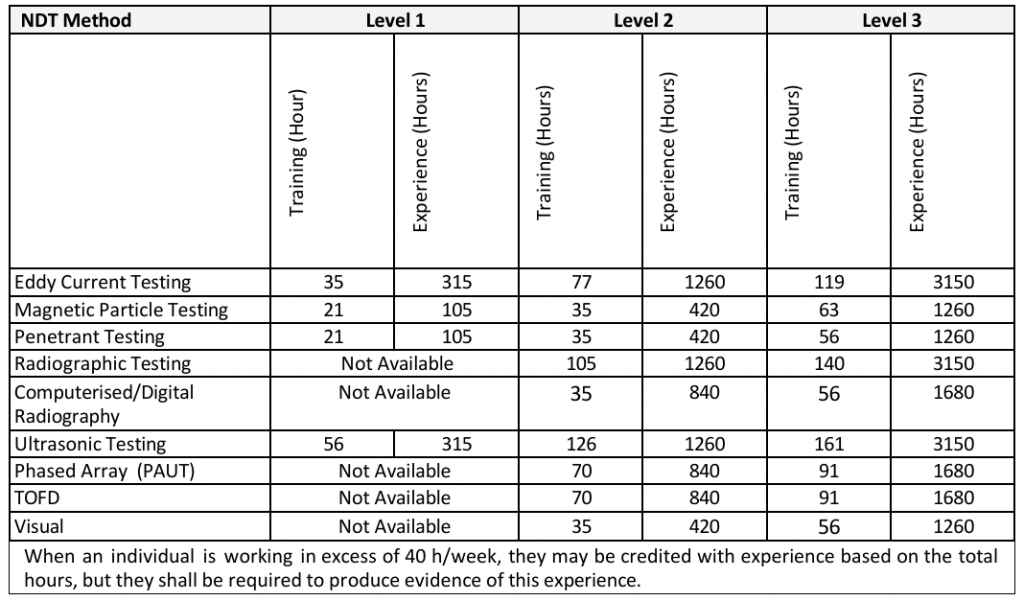Have some questions about NDT and training? See below for some common questions!
- What are the training and experience requirements for Level 1, 2, and 3 certifications?
- For Level 1 certification, the training hours range from 21 to 56 hours depending on the NDT method. Experience requirements range from 105 to 315 hours.
- Level 2 certification requires 35 to 126 hours of training, along with 420 to 1260 hours of experience.
- For Level 3 certification, the total training ranges from 56 to 161 hours, with 1260 to 3150 hours of experience.
- What happens if I have already completed training at a lower level?
- Training and experience at Level 1 are included in Level 2, and similarly, training and experience at Level 2 are included in Level 3. For direct access to Level 2 or Level 3, candidates must complete the combined hours required for all lower levels.
- What are the specific training and experience requirements for advanced techniques like Phased Array and TOFD?
- Phased Array Ultrasonic Testing (PAUT) and Time of Flight Diffraction (TOFD) require 70 to 91 hours of training and 840 to 1680 hours of experience. Prerequisites include holding an Ultrasonic Testing Level 2 certification.
- Can I gain certification through a structured experience program (SEP)?
- Yes, up to 50% of your required experience hours can be achieved through an SEP, where one day of attendance counts for up to five days of experience. This must be approved by the certification body.
- What are the prerequisites for limited application certifications like Tank Bottom Testing or Heat Treatment?
- Tank Bottom Testing requires 40 hours of training and 160 hours of experience, while Heat Treatment of welds using electrical resistance equipment requires the same. For limited applications, experience durations may be reduced but not below 15 days (105 hours).
- How is training structured and delivered?
- Training can be delivered in multiple formats, including face-to-face, distance learning, or self-paced formats. However, practical training must be instructor-led in person. All training for initial certification is valid for a maximum of ten years.
- What are the vision requirements for NDT certification?
- You must provide evidence of near vision acuity and colour vision before certification, and these tests must be renewed annually.
8. How to Transition into NDT from Another Technical Field
- Transitioning into Non-Destructive Testing (NDT) from another technical field is very feasible, especially if you already have a background in engineering, materials science, or a similar area. Start by leveraging any relevant technical skills you already possess, such as knowledge of materials or experience with quality control. You may be able to reduce the amount of required training and certification time based on your prior experience and education.
- Next, pursue specific NDT certifications (such as ISO 9712) that align with your skills and the industry you want to enter. Certifications are critical as they validate your competence in NDT methods and are often required by employers.
9. Starting Salary for an NDT Technician?
- The starting salary for an NDT technician varies depending on factors like location, industry, and certification level. On average, entry-level NDT technicians in the United States can expect to earn between $45,000 and $55,000 annually. With additional certifications and experience, salaries can increase significantly, often ranging from $60,000 to $80,000 or more for higher-level positions. Specialized roles in industries like aerospace or oil and gas tend to offer higher wages.
10. Demand for NDT Professionals
- The demand for NDT professionals is strong and growing, driven by the need for safety and quality in various industries. As infrastructure ages and industries expand, the need for qualified NDT technicians and engineers continues to increase, making it a stable and promising career choice.
11. What happens if I fail my exams?
- You’ve completed all your exams and not received the results to pass? don’t stress as you have two more tries after your initial exam to gain a passing grade. There must be a month between the initial attempt and the second try to ensure you have had enough time to prepare; We can hold the exam for you on our designated resit days and know we are here to help you.

Table: Guide to Qualification issue 22 Rev o4 2023
12. Want to find out everything about Guide to Certification and unsure where to look?
Follow this link to see the full guide: AINDT005_NDTCB_GUIDE_to_Qualification__Certification_Iss_22_Rev_04_ Feb_2023.pdf
If there are questions that aren’t answered, feel free to email us on info@kuzer.com or give us a call at 1300 199 086